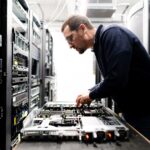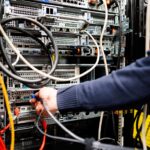The role of the CIO has been crucial to business success since the 1980s – overseeing the implementation and management of technology, and ensuring it supports company objectives.
However, the rapid digitization of the economy and growing reliance on technology for product and service innovation have prompted a major shift. In the IDG’s 2020 report, 95% of CIOs1 stated their role was now expanding beyond traditional IT management, with strategic tasks increasing from 4% to 25%.
As awareness of technology’s environmental footprint grows, the expansion of the CIO’s role positions them as strategic partners in using technology to generate revenue and achieve company objectives, while ensuring organizations reduce their environmental impact and remain competitive among customers, employees, and investors.
To achieve this, CIOs are harnessing data to implement green corporate strategies using technology, people, and processes to measure emissions, find ways to support a circular economy and decarbonize their operations.
Gaining clarity with data & insights
Growing demand for the manufacture of new equipment and poor asset management release vast quantities of CO2 and greenhouse gases into the atmosphere, warming the climate. In the last decade, the total life cycle carbon footprint of the IT sector accounted for approximately 1.4% of global greenhouse gas emissions2 with 60-80%3 of them coming from the production and use of terminal equipment.
In a Deloitte survey4 of 2,000 C-suite executives in 21 countries, nearly a third had difficulties measuring their organizations’ environmental impact. However, by leveraging data from enterprise applications and integrated platforms, CIOs can measure, monitor, and track a company’s carbon footprint using various metrics, such as greenhouse gas emissions, water usage and energy consumption.
With improved data sourcing and collection, CIOs can create greater internal visibility to identify areas of inefficiency, excessive emissions or waste, and implement appropriate countering strategies. One example is to migrate nonessential and mission-critical business functions to the cloud, with research finding that enterprises moving from on-site data centres have experienced energy savings of 80%5.
However, mass use of new technologies such as the cloud can also be very energy intensive (predicted to account for 8% of global electricity consumption by 20306), so it is key that CIOs partner with providers who are committed to carbon neutrality and use renewable energy sources.
In addition, emerging regulations are likely to demand increasing amounts of disclosure from business in future. In March 2022, the Securities and Exchange Commissions (SEC) voted to propose regulations that, ‘for the first time, require companies to disclose their greenhouse gas emissions as well as their exposure to climate change risks.’7 Therefore, it is beneficial for CIOs to establish robust and accurate data collection and monitoring practices now to save on potentially costly mandatory implementation down the line.
Building trust with transparency & communication
98% of consumers8 now believe brands have the responsibility to make the world better, and employees want to work for businesses that prioritize sustainability and embody their personal values9. As awareness of technology’s footprint grows, CIOs face stakeholder pressure to optimize their IT and align it with a greener economy.
As such, CIOs can leverage data to demonstrate their transparency and accountability for their enterprise environmental impact, helping to build trust among all stakeholders of all kinds – including customers, employees & investors.
CIOs can also use data alongside their technical knowledge and communication skills to encourage collaboration and create meaningful change towards green IT. Internally, breaking down and communicating organizational data, CIOs can increase understanding, facilitate productive discussions and strategy development with executives and across many different departments. Having a common enterprise-wide understanding of the issue and defining targets that align with the overall sustainability strategy, will also help the whole business collaborate effectively to reach them.
Moreover, sustainability is a long game. Some strategies that reduce environmental impact and create efficiency in the future may be more costly than maintaining the status quo in the short-term. Therefore, effective presentation and communication of data is essential for CIOs to tackle potential apprehension from executives and other business leaders, demonstrate how sustainable technology will support the overall success of the company long-term, and work with them to delegate resources in establishing a clear roadmap.
CIOs must also be able to establish external partnerships by exchanging relevant knowledge and insights to meet regulatory demands and improve sustainability across the IT industry. This includes communicating with vendors and suppliers and optimizing supply chains, which are responsible for approximately 80% of an organization’s emissions10.
Joining the circular economy
49% of organizations11 say implementing sustainable IT initiatives is a major challenge due to the lack of tools to evaluate their IT carbon footprint. In this capacity, data is also helping CIOs combat carbon emissions and waste by assessing the impact of their processes, including the procurement and use of equipment, and adjusting them so they support the circular economy.
According to Gartner12, CIOs are investing in innovative technologies such as AI and the Internet of Things (IoT) to improve the material sustainability of their tech. This includes the use of sensors that track the origin of a particular product, or AI signals to alert when a piece of equipment requires refurbishment.
These technologies can help inform a more analytical approach to IT Asset Management (ITAM) that encompasses acquisition, operation, and disposal to ensure maximum economic, material and environmental value of IT infrastructures at every stage of the lifecycle. In practice, this can be procuring high-quality refurbished assets from a reputable supplier instead of refreshing with new equipment. It also includes opting for a third-party maintenance service to support IT assets post-warranty, offering both a way to extend the useful life of equipment and avoid costly restrictions and refresh cycles imposed by manufacturers.
More broadly, as more CIOs adopt this approach, ITAM contributes to a weakening of the widespread practice of planned obsolescence, and huge amounts of functional equipment and reusable raw materials ending up as landfill every year. Moreover, once a business no longer requires a piece(s) of hardware, CIOs can generate extra revenue with a buy-back service, and if at its true end of life, give raw materials a second life by opting to recycle.
With more and more switching to this approach that strengthens the establishment of a circular economy in IT, CIOs are protecting their budget by reducing Total Cost of Ownership (TCO) and protecting the environment by preventing harmful e-waste and emissions at every stage of the hardware lifecycle.
Summary
The increasingly digital nature of global business is not slowing down. The data centre industry is expected to grow by 500% by 203013, making it ever more vital that CIOs take a leading role in contributing to industrial efforts and establishing the path to a less damaging digital future.
While using data to innovate new strategies and encourage collaboration to create meaningful progress, focusing on long-term solutions with the breadth and complexity to handle future challenges will be essential in prioritizing investments, divestments and making key business decisions – overall, making technology a key agent in actioning a brighter, more sustainable future for us all.
Sources
- ‘2020 State of the CIO Report.’ International Data Group (IDG). 2020.
- ‘ICT and the climate.’ Ericsson. 2020. (A quick guide to your digital carbon footprint – Ericsson)
- Godlovitch, Ilsa et al. 2021. ‘Environmental impact of electronic communications.’ WIK Consult and Ramboll. December 23, 2021.
- ‘2022 Deloitte CXO Sustainability Report.’ Deloitte. 2022. (2022 Deloitte CxO Sustainability Report | Deloitte Global)
- Henry, Nishita, John Peto, Shay Eliaz, Anjali Shaikh & Khalid Kark. 2022. ‘The CIO’s call to action: Driving an environmentally sustainable tech agenda to accelerate organizational change.’ Deloitte. May 18, 2022. (CIOs and sustainable technology | Deloitte Insights)
- Andrae, Anders S. G. & Edler, Tomas. 2015. ‘On Global Electricity Usage of Communication Technology Trends to 2030.’ MDPI. February 27, 2015. (Challenges | Free Full-Text | On Global Electricity Usage of Communication Technology: Trends to 2030 | HTML (mdpi.com))
- Freedman, Andrew. 2022. ‘SEC proposes first climate disclosure rules for public companies.’ AXIOS. March 21, 2022. (SEC proposes first mandatory climate risk disclosure rules (axios.com))
- Henry, Nishita, John Peto, Shay Eliaz, Anjali Shaikh & Khalid Kark. 2022. ‘The CIO’s call to action: Driving an environmentally sustainable tech agenda to accelerate organizational change.’ Deloitte. May 18, 2022. (CIOs and sustainable technology | Deloitte Insights)
- Daniel, Diann. 2022. ‘The CIO’s key role in environmental sustainability.’ TechTarget. March 22, 2022. (The CIO’s key role in environmental sustainability (techtarget.com))
- Bove, Anne-Titia & Swartz, Steven. 2016. ‘Starting at the source: Sustainability in supply chains.’ McKinsey. November 11, 2016. (Starting at the source: Sustainability in supply chains | McKinsey)
- ‘Sustainable IT: Why it’s time for a green revolution for your organization’s IT.’ Capgemini Research Institute. 2021.
- Gupta, Ashutosh. 2021. ‘How CIOs can get ahead on sustainability and ESG.’ Gartner. November 11, 2021. 5 Key Steps for CIOs to Drive ESG Initiatives (gartner.com)
- Andrews, Debra, Elizabeth J. Newton, Naeem Adibi, Julia Chenadec & Katrin Bienge. 2021. ‘A circular economy for the data centre industry: using design methods to address the challenge of whole system sustainability in a unique industrial sector.’ MDPI. June 2, 2021.




